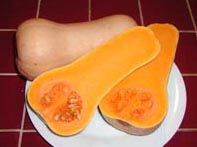Resource Library
Plant of the Week: Squash, Butternut
The University of Arkansas System Division of Agriculture does not promote, support or recommend plants featured in "Plant of the Week." Please consult your local Extension office for plants suitable for your region.
Plant of the Week
Butternut Squash
Latin: Cucurbita moschat
As Americans, squashes in their many and varied forms have been a part of our diet since the earliest times. The butternut squash is one of the bewildering assortment of squashes listed in the seed catalogs.
Butternut squash is a selection of Cucurbita moschata, one of four New World species in the pumpkin – squash – gourd complex that have been cultivated by Native Americans for at least 6,000 years.
These species interbreed promiscuously, and the origins of individual forms is murky. This species possibly originated in Argentina but was being grown in North America by the time European exploration commenced in the 16th century.
Butternut is a winter variety, one of the squashes with hard exterior shell and large, hard-shelled seeds. Because of their thick rind they can be stored for several months unlike their relatives, the thin skinned summer squash. Butternut is the tan colored, elongated, smooth skinned squash with a swollen base. It and the familiar acorn squash are the two most common winter squashes seen in groceries.
In the garden, it grows as a sprawling vine similar to its cousin the pumpkin, but without so much exuberance. Unlike the summer squash, which are harvested every few days to assure their succulence, winter squash are allowed to remain on the vine until the fruit develop the thick skin late in the season.
As the holiday season arrives and the pumpkin pies are wafting their fragrance from the oven, a discussion of this all-American food seems appropriate.
Pumpkins and the odd assemblage of squashes represent one of the three food crops cultivated by Native Americans at the time of European arrival. The others were corn (maize) and beans. The whole world quickly embraced corn and beans as staples, but pumpkins and squash never caught on in the rest of the world like they did here.
Pumpkin pies can be made from either winter squashes or from the more traditional pumpkin. In fact, the first pumpkin pies were made using hard shelled pumpkins that had a squash-like look. The earliest mention of a desert made from pumpkins was by Massachusetts Pilgrims soon after their landing in 1620.
Their method of preparation was to remove the top of a pumpkin, scoop out the seeds and then fill the cavity with sliced apples, sugar, spices and milk. The thick-skinned fruit was then baked in wood ashes until it was done. By 1673, the "Pumpion-Pye" had progressed to a kind of griddle cake with eggs added. In a 1796 cookbook, the pumpkin pie in its current form with a proper pie crust was described.
Orange-fleshed butternut squash are not usually used to make pumpkin pies, but they could be. Mostly, they are split and baked with spices and butter added for seasoning. This method is little changed from how the Pilgrims would have prepared the dish, except they didn’t have a microwave.
Butternut squash are warm season vegetables planted in hills spaced two feet apart in wide rows. Being intended for harvest at the end of the season, planting can be delay until June. Squash bugs are a serious problem with all squash. Scouting for the clusters of shiny brown eggs on the leaves is an early warning system important in control. Removing the eggs will help, but it’s hard to get them all. When young insects are first spotted, they should be dispatched with an appropriate spray while still young.
By: Gerald Klingaman, retired
Extension Horticulturist - Ornamentals
Extension News - December 9, 2005
The University of Arkansas System Division of Agriculture does not maintain lists of retail outlets where these plants can be purchased. Please check your local nursery or other retail outlets to ask about the availability of these plants for your growing area.
